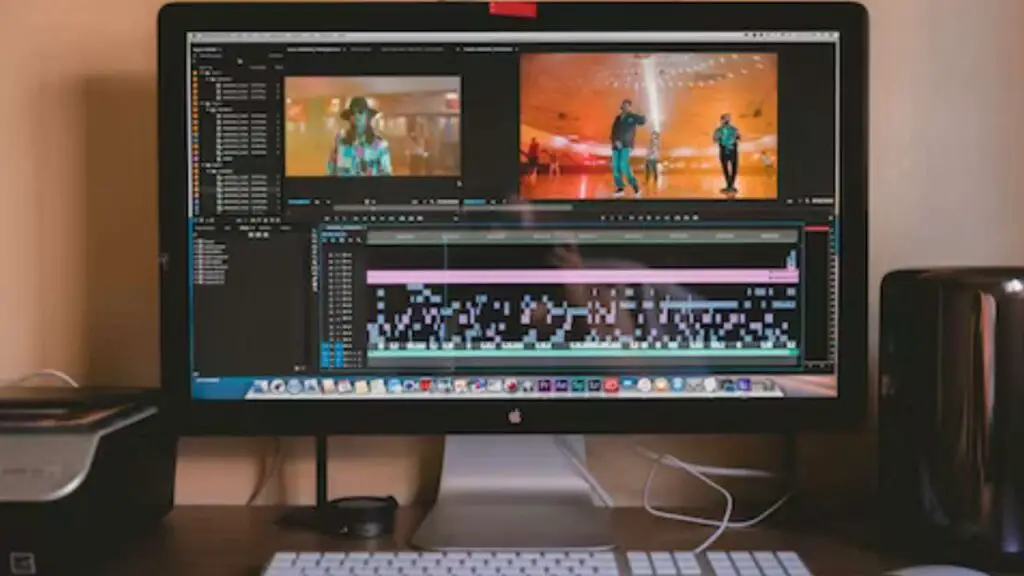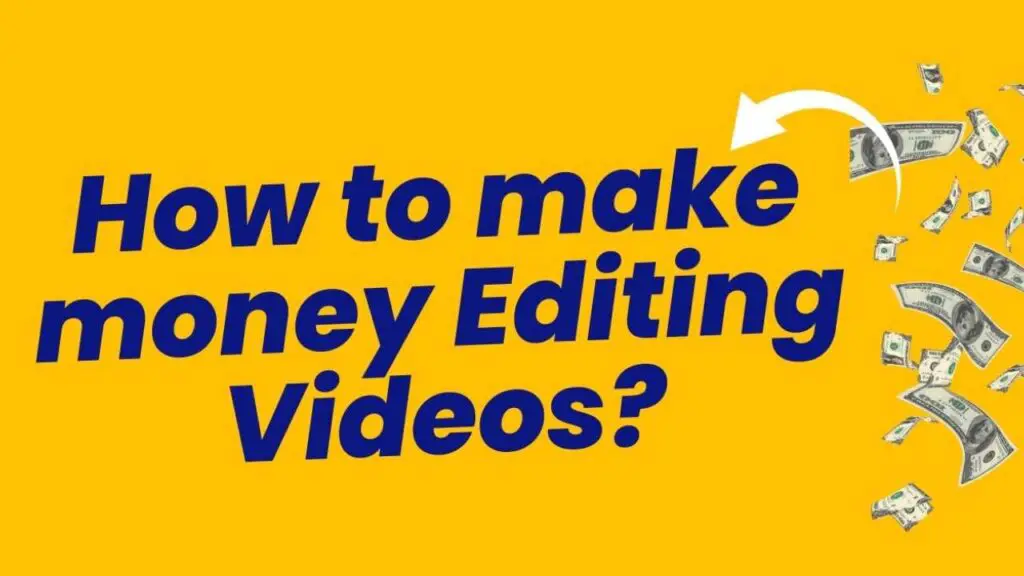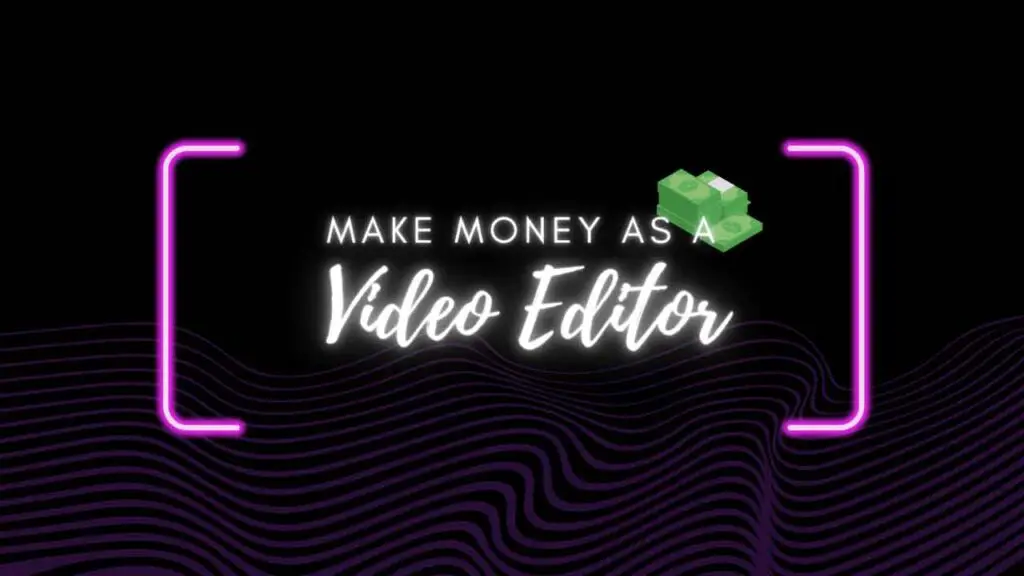THIS ARTICLE MAY CONTAIN AFFILIATE MARKETING LINKS! IN CASE YOU MAKE A PURCHASE THROUGH ONE OF THE LINKS, WE'LL GET A SMALL COMMISSION. WITH NO EXTRA CHARGES TO YOU. THANKS!!
Today, we’re diving into the exciting world of video editing and how you can turn your skills into a source of income. Whether you’re a seasoned pro or just starting out, there are several ways to make money editing videos. Let’s explore how to make money editing videos?
How to make money Editing Videos?
Freelance Video Editing
One of the most common routes for video editors is freelancing. Dive into the world of freelance video editing, and you’re in for an exciting ride. Freelancing can be a rewarding way to make money while doing what you love. Here’s a closer look at how to get started:
- Build Your Portfolio: Before you start offering your video editing services, it’s essential to have a strong portfolio. Create a showcase of your best work, demonstrating your skills in different styles and genres. Make sure your portfolio represents the kind of projects you want to work on.
- Choose Your Niche: Video editing is a broad field, and it’s a good idea to specialize in a niche. This could be anything from wedding videos to travel vlogs, corporate promotions, or even gaming content. Specializing helps you target your ideal clients.
- Set Your Rates: Determining your rates can be tricky, especially when you’re just starting. Research what other freelance video editors in your niche are charging and set your rates accordingly. Keep in mind your level of expertise and the quality of your work.
- Create an Online Presence: Establish your online presence. This means having a professional website or profiles on platforms like Upwork, Fiverr, or LinkedIn. Your online presence should showcase your portfolio, rates, and contact information.
- Network: Networking is crucial in the freelance world. Connect with other professionals in the video production industry, as well as potential clients. Attend industry events, join online communities, and don’t be afraid to reach out to potential collaborators.
- Marketing and Branding: Promote your services through various channels. Social media, content marketing, and email outreach can be effective. Also, work on branding yourself. A strong personal brand can make you stand out in a competitive market.
- Client Communication: Clear and prompt communication with clients is key. Understand their needs and vision for the project, and keep them informed about the progress. Building strong client relationships can lead to repeat business and referrals.
- Time Management: Freelancing requires excellent time management skills. Set realistic deadlines, manage your time efficiently, and deliver projects on time. This builds trust with clients and ensures a steady flow of work.
- Invest in Software and Equipment: Ensure you have the right software and hardware for video editing. Familiarize yourself with industry-standard software like Adobe Premiere Pro and DaVinci Resolve. Having a powerful computer and good editing software is essential for high-quality work.
- Continuous Learning: The video editing industry is always evolving. Stay updated with the latest trends, techniques, and software updates. Learning new skills keeps you competitive in the market.
Make a YouTube Channel
creating a YouTube channel for sharing your video editing skills and knowledge is a fantastic idea. Here’s a step-by-step guide to get you started on your video editing YouTube channel:
- Sign in or Create a Google Account: If you don’t have a Google account, you’ll need one to create a YouTube channel. Sign in with your existing account or create a new one.
- Set Up Your YouTube Channel: Go to YouTube and click on your profile picture in the top right corner. Click on “Your Channel” and then “Create Channel.” Choose a name for your channel. Since you’re focusing on video editing, consider a name that reflects your expertise or style.
- Customize Your Channel: Upload a profile picture and cover photo that represents your brand or style. Write a compelling “About” section that briefly introduces your channel and what viewers can expect. Add links to your social media profiles and website (if applicable).
- Plan Your Content: Decide what kind of video editing content you want to create. This could include tutorials, software reviews, editing tips, or breakdowns of your editing process. Make sure your content is valuable and relevant to your target audience.
- Get the Right Equipment: You don’t need super-expensive gear, but ensure you have a good camera, microphone, and video editing software. High-quality visuals and sound are important for engaging content.
- Create and Upload Videos: Start creating your video content. Make sure your videos are well-edited, have clear audio, and are engaging. Upload them to your channel.
- Optimize for Search: Use relevant keywords in your video titles, descriptions, and tags to improve discoverability. Create eye-catching thumbnails that reflect your video content.
- Consistency is Key: Upload videos regularly, whether it’s once a week, twice a month, or another schedule that suits you. Consistency helps build an audience.
- Interact with Your Audience: Engage with your viewers by responding to comments, asking for feedback, and listening to their suggestions. Building a community can be very rewarding.
- Promote Your Channel: Share your videos on your social media, in relevant online forums, and with friends and family. Promoting your channel helps to reach a wider audience.
- Monitor Analytics: Keep an eye on your YouTube Analytics to understand what’s working and what’s not. Use this data to refine your content and strategy.
- Stay Committed: Building a successful YouTube channel takes time and effort. Stay committed to your channel, keep improving your video editing skills, and adapt to the changing platform.

- How to make money as a Photographer?
- How to make money as a Video Editor?
- How to make money as Web Developer?
Online Courses and Tutorials
Creating online courses and tutorials is a fantastic way to share your expertise and knowledge, especially in the context of video editing. Here’s how you can get started with online courses and tutorials:
- Define Your Niche: Determine what specific aspect of video editing you want to teach. It could be beginner’s tutorials, advanced techniques, software-specific courses, or even niche topics like color grading or special effects.
- Choose a Platform: Select a platform to host your courses. There are several options, including: Udemy: A popular marketplace for online courses. Teachable: A platform that allows you to create and sell courses on your website. Skillshare: A subscription-based platform where you earn royalties based on student engagement. YouTube: If you prefer a free model, you can create video tutorials on YouTube and monetize through ads or sponsorships.
- Create Your Course Content: Develop a detailed outline of your course. Plan your lessons, create video content, and prepare supporting materials such as PDF guides, exercise files, or quizzes. Ensure your content is well-structured and easy to follow.
- Video Production: Invest in good-quality recording equipment. You’ll need a decent camera, microphone, and video editing software to produce high-quality video lessons. Well-produced videos enhance the learning experience.
- Recording and Editing: Record your video lessons, making sure your instructions are clear and easy to understand. Edit your videos to remove any mistakes or unnecessary content. Effective video editing is key here.
- Marketing and Promotion: Promote your courses through your own website or on the platform you’ve chosen. Use social media, email marketing, and other promotional strategies to attract your target audience.
- Engage with Students: Interact with your students, answer their questions, and encourage discussion within the course. Engagement fosters a sense of community and helps students learn better.
- Price Your Courses: Decide whether you want to offer free or paid courses. If you’re charging, research the market to set competitive prices. Some platforms have pricing guidelines to consider.
- Continuous Improvement: Gather feedback from your students and use it to improve your courses. Regularly update your content to stay relevant and competitive.
- Marketing Outside the Platform: Promote your courses on your personal website, social media, and other relevant platforms. Building your brand and reaching a broader audience can lead to more course sales.
- Monetization Models: Consider other monetization options, such as affiliate marketing, sponsorship deals, or creating premium content for paid subscribers.
Wedding and Event Videos
Editing wedding and event videos can be a lucrative and rewarding specialization in the field of video editing. Here’s a guide on how to get started in this niche:
- Build a Portfolio: Start by creating a portfolio that showcases your video editing skills. If you haven’t worked on wedding and event videos before, consider volunteering your services to friends or family to build a strong portfolio. High-quality samples are essential for attracting clients.
- Invest in Equipment: Ensure you have the right equipment for the job. This includes a high-quality computer with ample storage and a powerful video editing software like Adobe Premiere Pro or Final Cut Pro. Quality equipment is essential for delivering professional results.
- Networking: Establish connections with photographers, videographers, and event planners in your area. These professionals often collaborate on wedding and event projects and can be a source of referrals.
- Marketing: Create a professional website showcasing your portfolio, services, and contact information. Utilize social media to promote your work and connect with potential clients. Consider attending bridal and event expos to meet prospective clients face-to-face.
- Pricing: Set competitive pricing for your services. Research what other wedding and event video editors charge in your area. Consider offering different packages to cater to various client needs.
- Meeting with Clients: When you meet with potential clients, listen to their vision for the video. Understanding their expectations and preferences is crucial to delivering a product that meets their needs.
- Timely Delivery: Meeting deadlines is paramount in this business, as event videos often have tight schedules. Make sure you have an efficient workflow to deliver the final product promptly.
- Collaboration: Be open to collaboration with photographers and other event professionals. Coordination during the event ensures you capture all the important moments that need to be included in the video.
- Editing Style: Develop a unique editing style or approach that sets you apart from the competition. Understanding the emotional and storytelling aspects of weddings and events is vital.
- Customer Service: Excellent customer service is key. Be responsive to client inquiries, keep them updated on the progress, and be open to revisions based on their feedback.
- Legal Considerations: Ensure you have contracts and agreements in place that outline the terms of your services, payment, and copyright ownership of the final video.
- Continuous Learning: Stay updated with the latest video editing trends, techniques, and software. Continuous learning and improvement will help you provide top-notch services.
- Manage Your Workload: Don’t overcommit. Ensure you can handle the number of projects you take on without compromising on quality.
Stock Footage and Video Templates
Creating and selling stock footage and video templates can be a great way to monetize your video editing skills. Here’s a guide on how to get started:
- Select Your Niche: Determine the niche or themes you want to focus on for your stock footage and video templates. This could be anything from nature and travel footage to corporate templates or special effects.
- Shoot High-Quality Footage: Invest in a good camera and capture high-quality footage. Pay attention to factors like resolution, frame rate, and stability. You want your footage to be as versatile as possible for potential buyers.
- Edit and Organize: After capturing footage, edit it professionally. Remove any unwanted elements, enhance colors, and ensure the clips are well-composed. Properly categorize and tag your files for easy search and retrieval.
- Create Video Templates: If you’re offering video templates, use video editing software to create customizable templates for common video needs. These could be intro animations, lower-thirds, transitions, or other elements that content creators can easily incorporate into their videos.
- Choose a Platform: There are various platforms where you can sell your stock footage and video templates. Some popular options include Shutterstock, Adobe Stock, VideoHive (for templates), and even your personal website.
- Licensing: Decide on the licensing options for your content. This could include royalty-free or rights-managed licenses. Make sure you clearly communicate the usage terms to buyers.
- Marketing and Promotion: Promote your stock footage and video templates through your own website, social media, and online communities related to video editing and content creation. Engage with potential buyers and provide previews of your work.
- Pricing Strategy: Research the market to set competitive prices for your content. Consider offering different pricing tiers or bundles to attract a wider range of customers.
- Protect Your Work: Watermark your previews and take measures to protect your content from unauthorized use. This is especially important for video templates.
- Regular Updates: Continue to expand your portfolio with new and fresh content. Regularly updating your offerings can attract repeat customers and keep your profile active.
- Customer Support: Be responsive to customer inquiries and provide excellent customer support. Address any issues promptly and professionally.
- Legal Considerations: Ensure you have the necessary legal documentation in place to protect your rights and the rights of your customers.
Remember, making money through video editing takes time and effort. Building a portfolio, marketing yourself, and networking are crucial. Stay persistent, showcase your best work, and soon enough, you’ll be turning your passion for video editing into a lucrative career.







